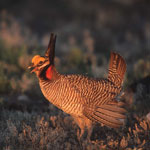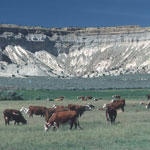
CEAP is a multi-agency effort to quantify the environmental effects of conservation practices and programs and develop the science base for managing the agricultural landscape for environmental quality. Project findings will be used to guide USDA conservation policy and program development and help conservationists, farmers and ranchers make more informed conservation decisions.
To download a spreadsheet of specific
conservation practices and links to CEAP products
that inform those practices, click here (XLSX; 0.1 MB).
To view a 20-minute recorded demonstration
on use of this spreadsheet, click here (YouTube).
Assessments in CEAP are carried out at national, regional and watershed scales on cropland, grazing lands, wetlands and for wildlife. The three principal components of CEAP—the national assessments, the watershed assessment studies, and the bibliographies and literature reviews— contribute to building the science base for conservation. That process includes research, modeling, assessment, monitoring and data collection, outreach, and extension education. Focus is being given to translating CEAP science into practice.
CEAP Vision... Enhanced natural resources and healthier ecosystems through improved conservation effectiveness and better management of agricultural landscapes.
CEAP Goal... To improve efficacy of conservation practices and programs by quantifying conservation effects and providing the science and education base needed to enrich conservation planning, implementation, management decisions, and policy.
. . . More about CEAP
What's New
- Wetlands: Science Note—A Novel Geospatial Modeling Tool Can Infer Wetland Function, October 2020 (PDF; 1.6 MB)
- Wildlife: Conservation Insight—Conservation Reserve Program Benefits Lesser Prairie-Chickens, October 2020 (PDF; 1.2 MB)
- Grazing Lands: Simulating Spatial Complexity in Dry Conifer Forest Restoration: Implications for Conservation Prioritization and Scenario Evaluation, September 2020 (PDF; 2.8 MB)
- Wetlands: Conservation Insight—Soil Influences on Water Balance in Wetlands May Impact Wetland Effectiveness in Achieving Different Restoration Objectives, August 2020 (PDF; 1.6 MB)
- Wildlife: Video Briefing: Outcomes from NRCS Golden-Winged Warbler Conservation Efforts, July 2020 (YouTube)
- Wetlands: Use of Topographic Models for Mapping Soil Properties and Processes, June 2020 (PDF; 1.7 MB)
- Wetlands: Assessment and Combination of SMAP and Sentinel-1A/B-Derived Soil Moisture Estimates With Land Surface Model Outputs in the Mid-Atlantic Coastal Plain, June 2020 (PDF; 2.5 MB)
- Wetlands: Assessing the Effectiveness of Riparian Buffers for Reducing Organic Nitrogen Loads in the Coastal Plain of the Chesapeake Bay Watershed using a Watershed Model, June 2020 (PDF; 2.6 MB)
- Watersheds: Measuring and Understanding the Effects of Conservation Within Watersheds, Special Issue of Journal of Soil and Water Conservation covering 15-years of CEAP-Watersheds research in 15 peer-reviewed papers, May 2020. NRCS press release, May 13, 2020.
- Watersheds: Making Conservation Count: The Importance of Assessing Resources and Documenting Outcomes to USDA, May 2020 (editorial by FPAC Under Secretary, Bill Northey)
- Wetlands: Modeling the Supporting Ecosystem Services of Depressional Wetlands in Agricultural Landscapes, April 2020 (PDF; 0.4 MB)
|
|

A sampling and modeling approach using data from representative crop fields, from the National Resources Inventory, and farmer surveys to estimate impacts of conservation practices on the environment. |

An effort to develop a collaborative foundation that facilitates the production and delivery of scientific data to inform conservation decisions affecting wetland ecosystems and the services they provide. |

A cooperative effort with the fish and wildlife conservation community involving multiple regional assessments that document habitat condition and biological response to conservation practices and programs at multiple spatial scales. |

An effort designed to quantify the environmental effects of conservation practices on non-Federal grazing lands in the United States. |

New: In 2019, CEAP has 23 active watershed projects, including these 3 new ones to identify more effective conservation practices promoting the following outcomes:
Ohio’s Western Lake Erie Basin – better water quality.
California’s Central Valley – improved water availability, recharge, and quality.
Vermont’s Lake Champlain Basin – better water quality, innovative practices and planning tools.
Fifty-one CEAP watershed studies have been initiated to provide in-depth analysis and quantification of the measurable effects of conservation practices at the watershed scale and enhance our understanding of the effects of conservation in the biophysical setting of a watershed.
These studies are being conducted and/or supported by USDA's Agricultural Research Service, National Institute of Food and Agriculture, and Natural Resources Conservation Service. Future efforts will include translating this science into practice to better manage agricultural landscapes.
Current literature on conservation programs that documents what is known and not known about the environmental benefits of conservation practices and programs for cropland, fish and wildlife, wetlands, and grazing lands. The National Agricultural Library maintains dynamic bibliographies cataloging studies from 2003 to the present.
Publications
A full listing of all CEAP-related documents published to date.
Review CEAP documents by region and assessment via interactive map.